Menu
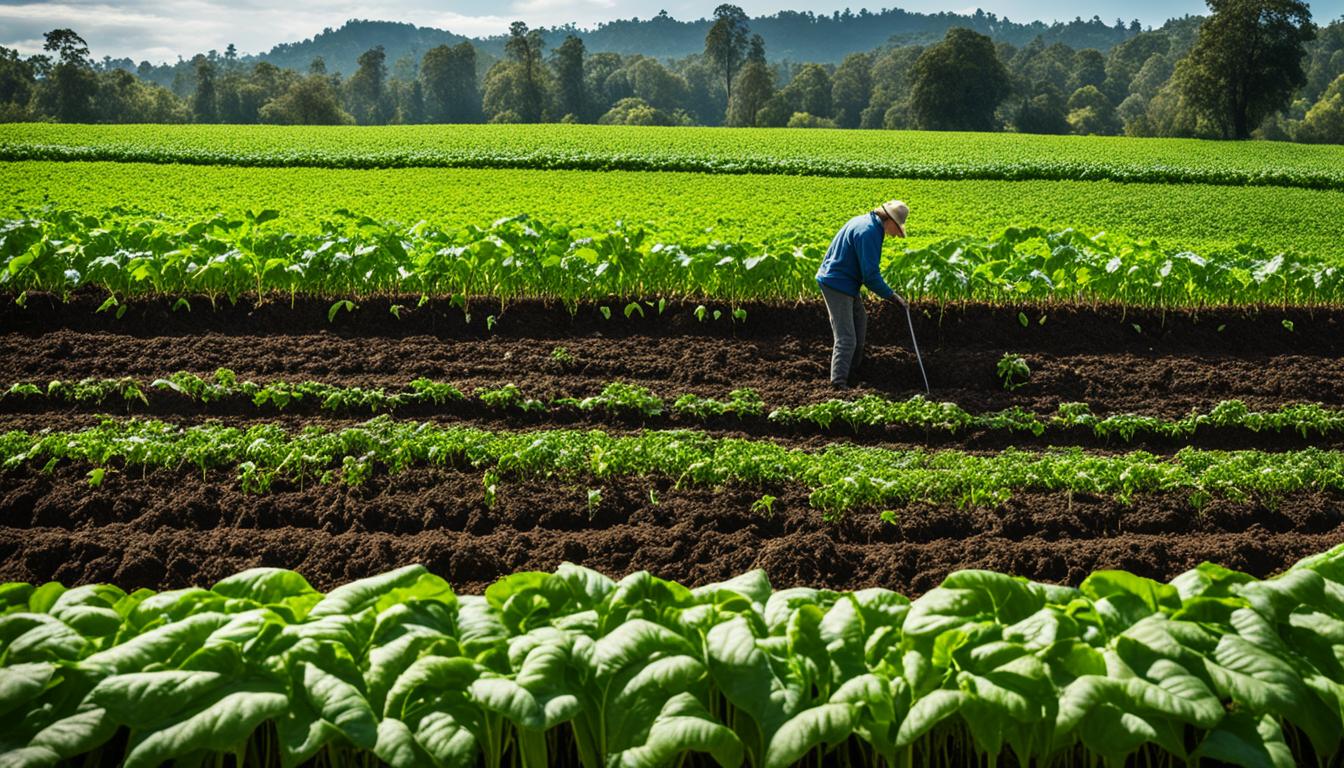
Did you know that organically managed soils have 8.33 percent organic matter? This is more than conventionally managed soils that have 7.37 percent. This shows how organic farming boosts soil health. The US struggles with topsoil loss because of non-sustainable farming. Sustainable and regenerative farming highlight the importance of soil health. This is crucial for food, ecological balance, and vitality.
Understanding the link between organic practices and soil health is crucial. Healthy soils help with water retention and support diverse life. They are key in fighting climate change. Organic farming is a beacon of hope for improving soil’s health. It does this by adding organic carbon and keeping biodiversity. This ties with regenerative farming and good soil management.
Soil health is key to sustainable farming. It describes soil as a living system that supports life. It’s vital for plants, animals, and people. Good soil health means the earth can grow food well.
Soil health means the ground can support life. This includes how well it feeds plants, animals, and us. Physical, chemical, and biological parts all matter. Organic farming makes soil better at these things.
It helps soil hold water and grow rich food. This is better than using only chemicals. Better, healthier soil means more food and less impact on the planet.
Good soil helps crops grow strong. Organic soil with natural matter holds water and nutrients well. This makes food crops tough in weather changes. Also, diverse life in organic soil boosts plant health.
This shows why soil health is so important for growing food without harm. Healthy soil means better crops. Plus, it’s good for the environment.
Organic farms help our planet in big ways. They use cover crops and different plants to keep soil rich. This supports a lively underground world of tiny creatures.
Healthy organic soil can also fight climate change. It locks away more carbon. This shows how important good soil is for a strong nature.
Evaluating soil health is crucial for sustainable and regenerative farming. Scientists look at physical, chemical, and biological indicators. These tell us about the soil’s quality and its ability to grow plants and sustain ecosystems.

Physical indicators check the soil’s structure. They look at:
Chemical signs of soil health look at nutrients and other chemical traits. They focus on:
Biological signs highlight the life in the soil. They include:
Here’s a table with key soil health information for easier understanding:
| Specific Indicators | Description | |
|---|---|---|
| Physical | Aggregate stability, Water-holding capacity, Infiltration, Runoff susceptibility | Shows the aspects of soil like stability and ability to retain water. |
| Chemical | Nitrogen, Phosphorus, Potassium, pH, Cation exchange capacity | Deals with soil nutrients and chemical balance. |
| Biological | Organic matter, Microbial biomass, Earthworm abundance, Weed pressure | Looks at the life and organic part of the soil. |
Tracking these indicators helps us thoroughly assess soil quality. This is key for good choices in organic farming.
Organic soil amendments are key to making soil rich and healthy. Farmers use things like compost and manure. This makes the soil full of nutrients and also stores carbon. These things make farming more eco-friendly. They make the soil better in every way and help create a strong ecosystem.
There’s a lot of organic stuff that can help the soil. Here are the main ones:
Compost is really great for the soil. It’s been shown to make the soil’s health better. There was a study of 153 reports that proved this. Compost is awesome because it makes the soil hold water and nutrients better. It also doesn’t change the way the soil’s good bacteria works. Plus, it’s easier to move around than fresh manure. It has less water, and fewer weed seeds too.
Manure is important because it gives plants the nitrogen they need quickly. This is especially good for big crops like corn. Fresh manure has more nitrogen for plants than the kind that’s been composted. How manure affects the tiny life in the soil and the enzymes depends on how much and how often you use it. This is why farmers need to plan how they use manure to make the soil as good as it can be.
Cover crops are essential in sustainable farming. They bring many advantages like fixing nitrogen, preventing soil erosion, and cutting down weeds.
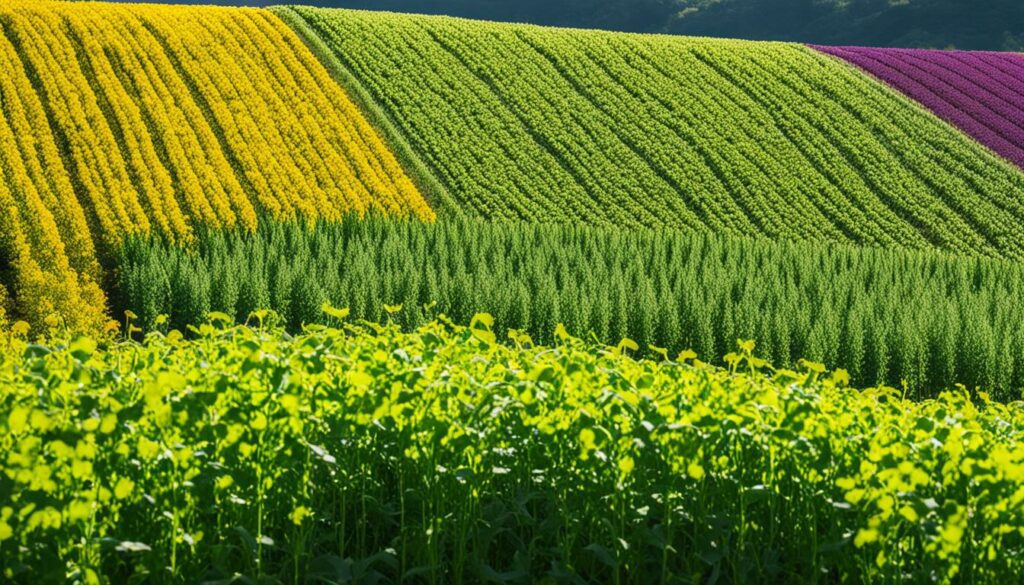
Legumes are outstanding at turning air’s nitrogen into a form plants can use. When these are used as cover crops, the next crops grown can use up to 60% of this nitrogen. For example, using hairy vetch can make growing corn without tilling more profitable than if you followed winter wheat without it.
Grains or grasses with deep roots help stop soil erosion. These plants can take in up to 71 lb. of nitrogen in three months, which stops nitrogen loss. This helps keep the soil from washing away and keeps crop yields high. Winter wheat and clover are examples of cover crops that help with this.
Cover crops also help in stopping weeds from growing. When grains and grasses are planted in the fall, they cover the ground and lessen the need for herbicides. A rotation like corn-rye-soybeans-wheat-hairy vetch has shown it can reduce weed killers but still be profitable. This way, cover crops make the environment healthier by cutting down on harmful chemicals.
| Cover Crop | Benefit | Example |
|---|---|---|
| Legumes (e.g., Hairy Vetch) | Nitrogen Fixation | Improves no-till corn yield |
| Fibrous-rooted Grains | Soil Erosion Prevention | Absorbs up to 71 lb. Nitrogen/acre |
| Fall-seeded Grains/Grasses | Weed Suppression | Reduces reliance on herbicides |
Cover crops are key to sustainable farming. They stop topsoil loss, add nitrogen to the soil, and keep weeds under control. Using cover crops not only boosts crop production, but it also makes farming more environmentally friendly.
Crop rotation is key to keeping our soil healthy. Farmers change the types of crops they grow to protect the land. This method improves soil texture, cuts down on soil loss, and keeps nutrients moving smoothly.
It’s important to grow many different crops one after the other. Rules set by the USDA say farmers must switch up their crops. This keeps the soil rich and healthy. They plant things like sod, cover crops, and green manure at different times.
It’s also vital to make sure crops have all the food they need. Using plants like clover can add important nutrients to the soil. This helps both the plants and the tiny organisms that live in the soil.
Farmers plan out what to grow and when very carefully. They spread their crops out so the soil doesn’t get tired of the same thing. Doing this also helps lots of different plants and animals thrive on the farm.
Growing different crops at different times is really good for the earth. It helps fight off bugs, weeds, and sickness in plants. For example, switching between growing corn and soybeans can make your harvests bigger. This was seen in studies that compared these methods.
Even in tough times like droughts, changing crops can really help. It has been shown to reduce losses by a lot. What’s more, it keeps the soil rich up to 5 feet deep. This is great for the earth over a long time.
By rotating crops, the land stays healthy and there’s less waste. It keeps the soil wet enough and encourages many different living things. All these things help farmers keep their fields working well for a long time.
| Rotation Type | Yield Improvement | Drought Resilience | Soil Organic Carbon |
|---|---|---|---|
| Continuous Cropping (CC) | Baseline | Baseline | Lower |
| Grain Sorghum-Soybean (GS) | Improved | Moderate | Higher |
| Corn-Soybean (CS) | 29% with Fertilisation | Significant | Higher |
| Corn-Oat/Clover-Grain Sorghum-Soybean (COGS) | Varied | High | Highest |
Soil microorganisms are key in organic farming. They ensure soil health by enhancing nutrient availability, controlling diseases, and encouraging biodiversity. In the absence of synthetic additives, their role is even more crucial. We will look at how these organisms work and ways to boost their positive impact.
The variety of microorganisms in the soil is vital for its health. Organic farming enhances this mix, including bacteria, fungi, and archaea. They help recycle nutrients, break down dead plants and animals, and aid in environmental resilience.
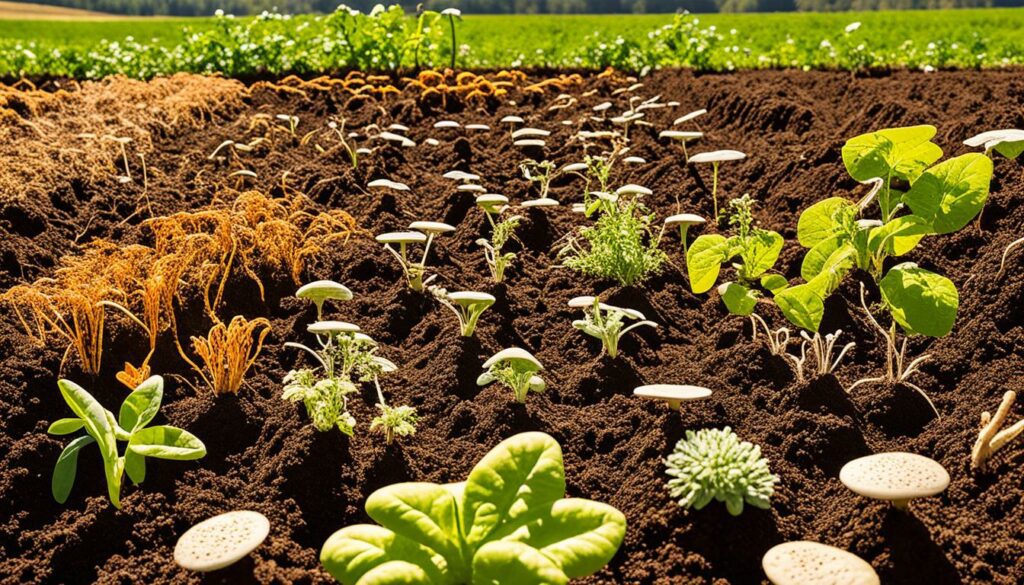
Soil microorganisms are essential for organic farming. They recycle nutrients, helping plants grow. They also release substances that aid plant growth and fight off harmful diseases.
Farmers boost beneficial microbes by using special products. These may be biofertilizers, biopesticides, or substances that help plants grow. They are full of helpful microbes and fungi.
Things like compost and manure also introduce good microbes to the soil. While they can improve soil and increase crop yields, their effect depends on the farm’s specific situation. Managing soil microbes is critical for their best use.
Conservation tillage is key in sustainable farming, improving soil, holding water, and increasing crop yield. In the USA, these methods covered 173 million acres by 2012. This not only boosts soil health organic farming but tackles soil erosion and improves its structure.
Conservation tillage stands out in cutting soil erosion. In northern Mississippi, using no-till gear dropped soil loss by 86 percent on certain soils compared to traditional ploughing. And in the Southern Coastal Plain, erosion fell greatly on different soil types under conservation tillage.
| Region | Erosion Reduction | Tillage Type |
|---|---|---|
| Northern Mississippi | 86% | No-till |
| Southern Coastal Plain | Significant | Conservation tillage |
Conservation tillage also boosted soil’s natural content by 56 percent in the Southeast. This improves overall soil quality.
Conservation tillage greatly helps soil structure. It keeps the soil covered with plant remains. This cools the soil, keeps moisture, and boosts life in the earth. For instance, runoff was much less on fields with conservation tillage compared to ploughed fields in Alabama.
| Location | Runoff Loss – Conventional Tillage (mm) | Runoff Loss – Conservation Tillage (mm) |
|---|---|---|
| Southeast Silt Loam | 28.7 | 16.7 |
| Southern Coastal Plain, Alabama | Double | Half |
Plus, conservation tillage cuts the need for machinery by over 40%, which saves time and money. It improves soil and helps farming be more profitable. For instance, cotton yields had 10–37 percent more profit using conservation tillage instead of ploughing. This shows how conservation tillage is vital for both the Earth and farming’s economy.
Intercropping is a key part of organic farming. It combines multiple crops in one field, boosting the soil’s health. It makes the ecosystem more diverse, improves how nutrients move, and helps control pests. This makes farming stronger and better for the environment.
Intercropping can significantly increase the variety of plants in an area. This mix lowers the need for harmful chemicals. It also improves the soil and creates a healthier environment. More types of plants help the microorganisms in the soil, which is vital for healthy farming.
Intercropping supports better use of nutrients. Different crops are placed strategically to share nutrients well, improving soil fertility. For example, some crops help fix nitrogen for their neighbours, increasing harvests by a quarter. This method helps crops get more nutrients from the soil, reducing the need for artificial fertilisers.
Intercropping helps fight pests by making it hard for them to grow and spread. By planting a range of crops, certain pests are kept away without using chemicals. This keeps the soil’s natural systems in balance, which is crucial for healthy farming.
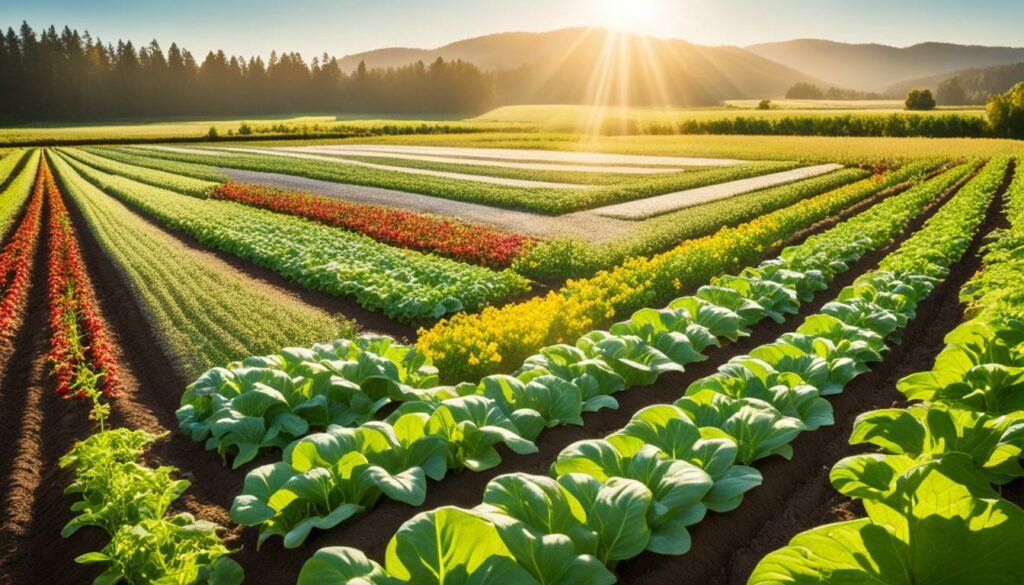
| Benefit | Impact |
|---|---|
| Increased Biodiversity | Reduction of pesticides and herbicides by up to 30% |
| Enhanced Nutrient Cycling | Increase in nutrient availability by approximately 15% |
| Improved Pest Management | Reduced crop failures by up to 35% |
In conclusion, intercropping does a lot for the soil. It boosts biodiversity, improves how nutrients move, and fights off pests. This makes farming better and smarter. Intercropping plays a big role in creating strong, efficient, and eco-friendly organic farms.
Organic farming relies on key principles for effective soil management. These include minimising soil disturbance, keeping the soil always covered, and planting a variety of crops. They help to maintain soil productivity and support a farming system that’s good for the land.
It’s key to avoid disturbing the soil to protect the life within it. Techniques like no-till or reducing tillage keep the soil’s structure intact. This helps good bacteria thrive and improves the cycling of nutrients in the soil. It’s a way to keep the soil healthy without losing vital carbon from composts and manures.
Keeping the soil covered at all times is vital to prevent erosion and to stop weeds growing. Farmers use cover crops like legumes and grasses between main crops. This stops the soil from washing away, increases its fertility, and helps store carbon away. This means the soil can support more life and farm crops with less negative impact.
Growing varied crops through methods like switching crops in fields or growing different ones together is good for the soil. This practice reduces soil problems and adds more nutrients for plants to use. Extended rotations make the soil stronger against weather and keeps yields steady. In the table below, you’ll see how these organic methods outshine traditional ones:
| Organic Soil Management Practices | Benefits | Conventional Practices |
|---|---|---|
| Minimal Soil Disturbance | Improves soil structure, increases microbial activity | Frequent tilling, leads to soil degradation |
| Continuous Soil Cover | Prevents erosion, enriches soil organic matter | Often bare soil, high erosion risk |
| Crop Diversity | Enhances nutrient cycling, improves soil fertility | Monocultures, low biodiversity |
Following these basic rules is crucial in making farms work well with nature. By protecting the soil, covering it, and mixing up crops, organic farmers build farms that are strong and productive. This way, everyone wins: the earth, the crops, and the people who eat them.
Carbon sequestration in soil is key in battling climate change. Since the Industrial Age, we’ve raised carbon dioxide in the air by 45%. Sadly, soils have lost 50-70% of their carbon.
So, it’s crucial to boost carbon sequestration in soil.
Carbon sequestration in soil plays a huge part in lessening climate change. The Earth’s forests, farms, and grasslands catch about 25% of carbon emissions. In the U.S., 44.37% of land is for farming, showing great promise.
Analyzing 68 datasets found that switching to organic farming boosted soil carbon by 2.2% per year.

There are key practices that boost carbon sequestration in soil. Organic farming is a success. It includes using things like compost and manure which improve soil health.
Cover cropping is also great. It helps capture carbon and boosts soil health in organic farming. Yet, not all methods show consistent soil carbon increases. This shows that proper management is vital.
| Practices | Benefits |
|---|---|
| Organic Amendments | Enhance soil nutrients and increase SOC. |
| Cover Cropping | Improves carbon capture and soil health. |
| Crop Rotations | Optimises soil physical properties and reduces nitrogen leaching. |
Keeping soil healthy with organic farming is key in sequestering carbon. This offers a powerful tool in fighting climate change. It’s crucial to study the factors influencing soil carbon storage closely.
Managing soil health in organic farming is tough. Finding the right balance between soil health and crop production isn’t easy.
Organic soil amendments vary a lot in their content and nutrient levels. Things like compost and manure change a great deal based on where they come from. This makes it hard to know exactly how they’ll affect the soil’s health.
Getting reliable soil health data is hard. Over the last 30 years, studies have shown mixed results. This makes it tough to set universal standards for soil quality. Keeping track of things like organic carbon and soil microbes is tricky because of these challenges.
Making sure nutrients from organic changes match the crop’s needs is hard. If not timed right, it can cause problems like nutrient shortages or too much. This affects the soil and the crops. Plus, it’s necessary to grow cover crops to high levels for some farming methods.
These problems show why we need constant research in organic farming. We need to improve our practices to deal with these tough issues.
In the study of organic farming, several key areas need more research. These include making data more unified, studying practices specific to regions, and researching soil health over the long term. All of these are very important.
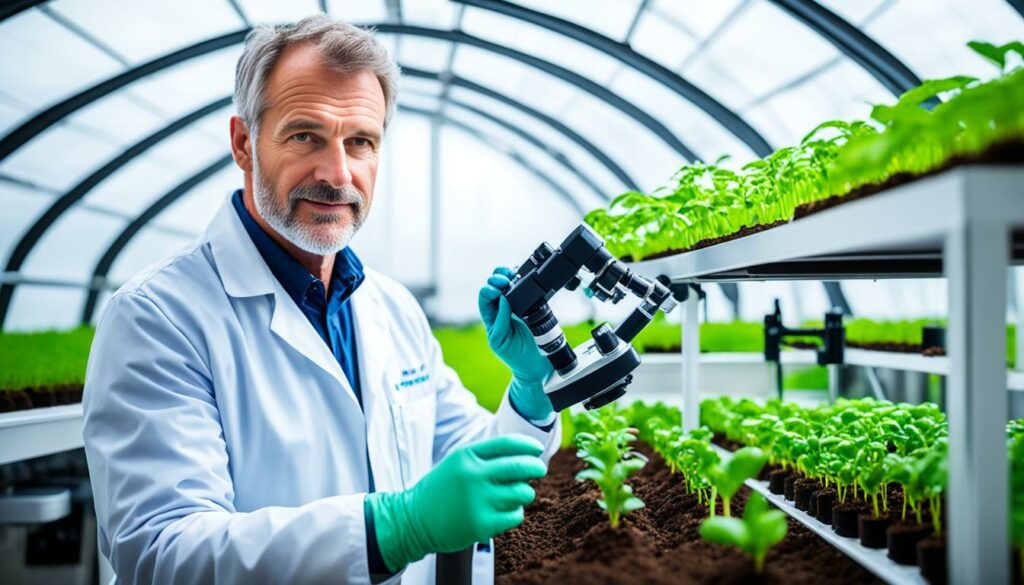
It’s hard to move forward in studying soil health because everyone uses different data. To solve this, we need to agree on how to measure soil health. This agreement will let us compare results from different places. It will also help make farming more sustainable everywhere.
Studies show that how well soil is doing changes by region. This is because of the way people farm and the local environment. We need to look closer at these differences. By doing this, farming methods can be improved to fit each area better.
Doing research over many years is key to fully understanding organic farming’s benefits. This kind of work shows us why organic soils are better. They hold more water, are more porous, and keep their shape better. This research also highlights how good these soils are at trapping carbon, which helps fight climate change.
To wrap it up, we’re on an important journey in organic farming research. We must work on making data more the same, understanding regional differences, and doing long studies. These steps will lead to better farming techniques. These techniques will be good for the land and our planet.
The journey through organic farming’s soil health management shows its key role in long-term agriculture. Studying different practices reveals a strong link between soil life and farming that helps the environment. Research funded by the USDA from 2002-2016 proves that a rich variety of soil life improves soil’s health. It also helps with water use, recycling nutrients, and controlling pests.
I looked closely at how ploughing affects tiny soil creatures, changing crops, and how nutrients move. The focus was on looking after the soil’s tiny life to keep the soil, crops, and environment healthy. Including beneficial microbes and other products becomes part of a big picture in farming. This supports the core ideas of sustainable farming.
Even though there are some hurdles, like the difference in natural materials and tricky data, knowing what makes soil healthy and different organic farming methods helps a lot. Cover crops, farming without digging, and using organic materials show how organic farming can adapt and flourish. With 6 million acres now being farmed organically in the U.S., the use of cover crops is showing good results. It proves that organic farming is becoming more popular.
Soil health management in organic farming is more than just growing crops. It’s a whole way of farming that makes the land strong and keeps nature in balance. By adopting these methods, we’re shaping a future where the earth and our food can grow together in a healthy way.
Soil health means soils are alive and benefit everything that grows, including us. It covers everything about how fertile and productive soil is. This includes the life it supports, its chemistry, and its physical makeup.
Good soil helps crops grow better and healthier. It gives them the nutrients they need and keeps water where they can reach it. Healthy soil also fights off pests and diseases, making farms more stable.
Healthy soil is crucial for nature to thrive. It supports many living things, helps with water, and even fights climate change by storing carbon.
We look at how soil holds its shape, how it holds water, the levels of key nutrients, and the life it contains to figure out if it’s healthy. These tell us a lot about soil health.
Things like compost, manure, green manure, and cover crops are used. They make the soil better by adding nutrients, helping good bacteria, and increasing the amount of organic material in the soil.
Compost adds important nutrients to soil and makes it soak up water better. It also helps good bacteria to grow. All this keeps the soil fertile and healthy.
Manure makes the soil richer with nutrients and organic stuff. It boosts the activity of helpful bacteria and improves the structure of the soil. Different manures have different nutrients they offer.
Cover crops do a lot of good things. They add nitrogen to the soil, stop it from washing away, and block weeds. They keep the soil strong and fertile, making a better place for plants to grow.
Changing what’s planted in a field helps the soil in many ways. It stops the soil from washing away, reduces a kind of pollution, and adds organic matter. This makes the soil better for growing crops.
Tiny living things in the soil do a lot for growing plants. They help with nutrients, water, and protecting plants from sickness. Using organic methods helps more of these helpful organisms to live in the soil.
Farming practices that don’t disturb the soil much are good for it. They keep the soil from blowing or washing away, keep it in good shape, and help it hold on to water. This all makes the soil healthier and more sustainable.
Intercropping means growing different plants together. It helps the soil by making a better environment for nutrients, managing pests, and using space wisely. It’s like teamwork for plants.
Good soil care in organic farming means not disturbing it too much, leaving it covered, and growing a variety of plants. This keeps the soil’s ecosystem strong and helps farms last for a long time.
Soils that store carbon help slow down climate change by using up some of the pollution in the air. Methods like adding organic stuff and planting cover crops make this happen more.
It can be hard to know the best way to use natural materials on soil. Plus, it’s tricky to measure soil health in a consistent way. Timing the release of nutrients to match plant needs is also a challenge.
Researchers want to get better at sharing and understanding information about the soil. They also aim to figure out what works best in different places and to show the long-term benefits of looking after the soil well.